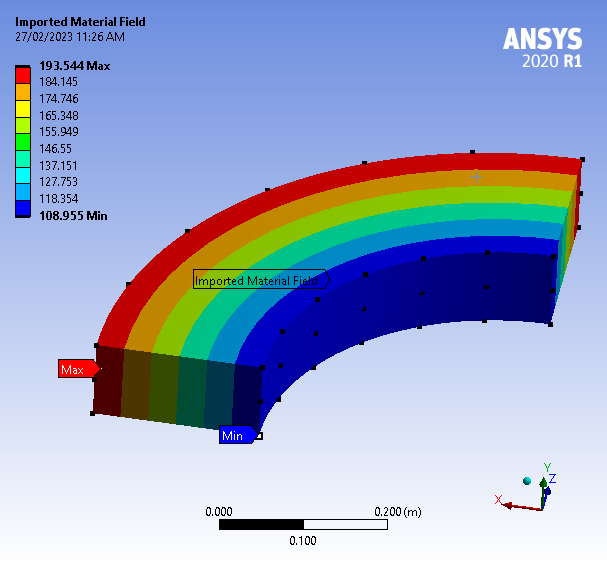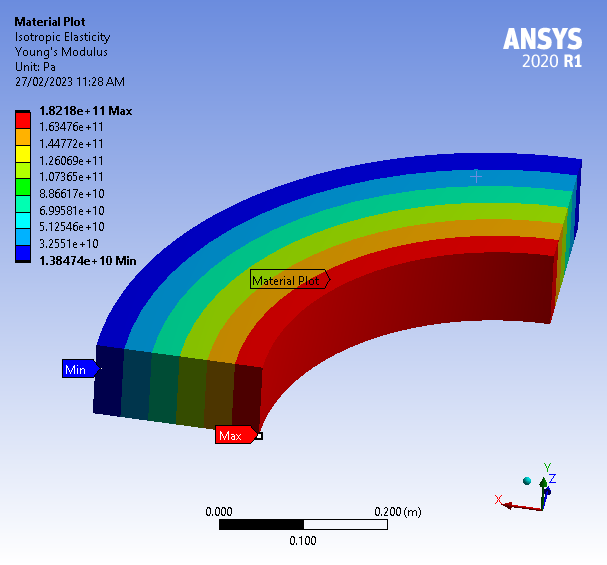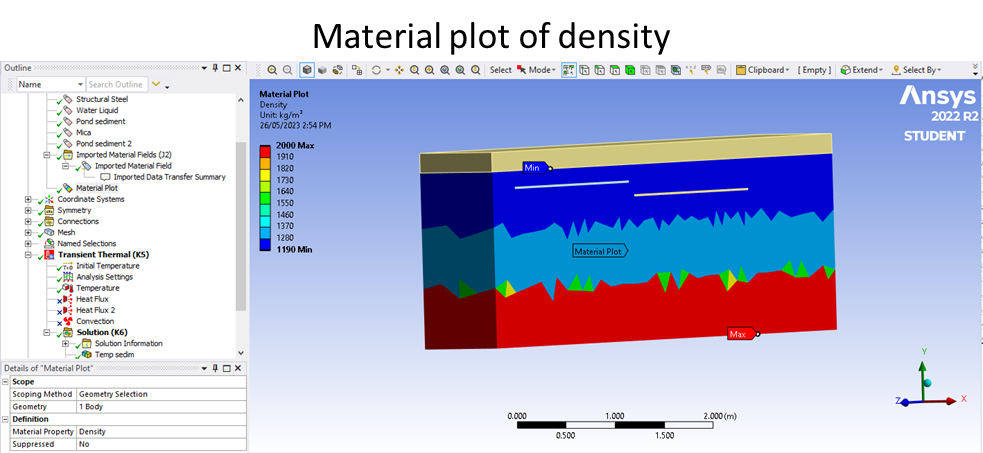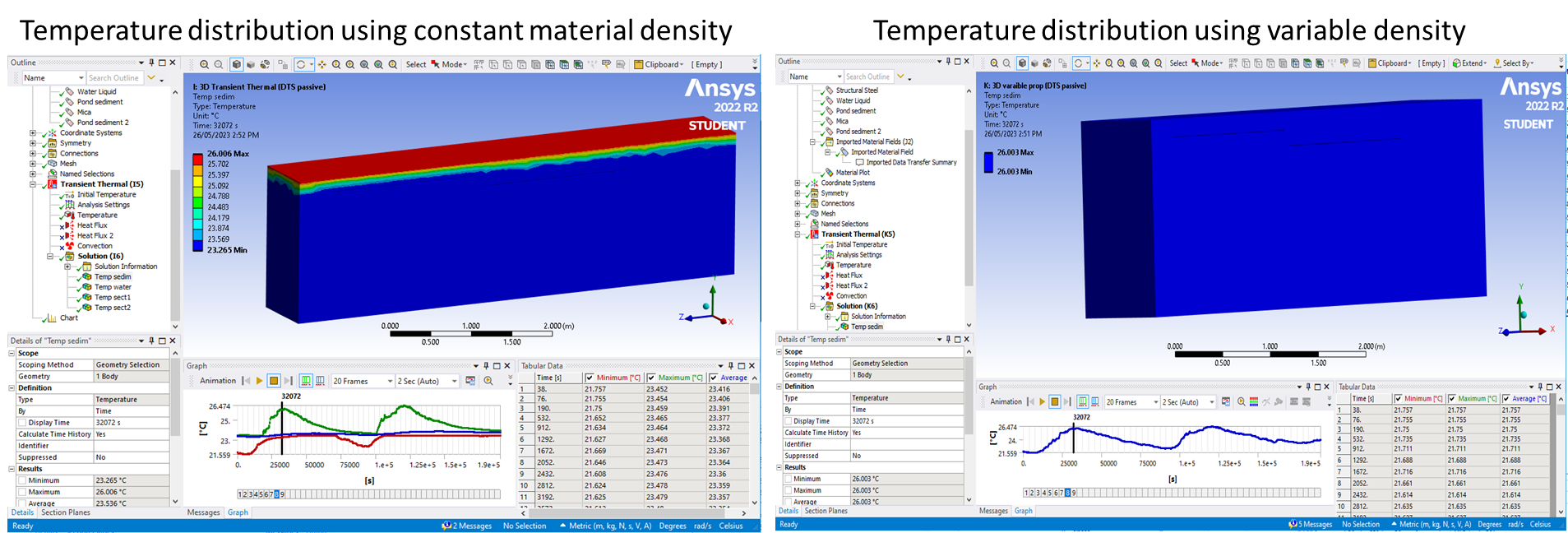-
-
February 27, 2023 at 1:10 am
Chee Min Leong
SubscriberHi,
I am trying to vary the young's modulus of a hollow cylinder. In my case, the Young's modulus decreases radially.
I followed the instructions here https://www.padtinc.com/2022/02/03/hold-my-beer-spatially-varying-materials-in-ansys-mechanical-made-easy/
for a cube and applied it to a hollow cylinder.Since the model I am working with is symmetrical, I have set up quarter symmetry and my final result is shown below.
Figure 1 - Source Points & Score
Figure 2 - Material Plot
Figure 3 - Young's modulus vs Score
Figure 2 shows the young's modulus changing radially but the minimum value is not 1E+9 as shown in figure 3.
So, my questions are,
- Why is the minimum value not what I wrote and how can I fix it?
- How many source points do I need to map the material properties accurately?
Please let me know if you need more information.
-
March 8, 2023 at 10:49 am
Ashish Khemka
Forum ModeratorHi,
Is the 'r' value 100 where you expect 'E'=1E9 Pa? Also, if you have the nodes numbers, their location then try using the E values with node number and location for mapping the material property.
Regards,
Ashish Khemka
-
May 26, 2023 at 4:57 am
Laure
SubscriberHi Ansys community,
Thank you for this post. I am trying to assign variable density to a body in my transient thermal model. I have also followed the procedure suggested on PADT website and got the desired material plot (attached image). However, when I run the model there is not any temperature variation, which is incorrect. Now, If I use a constant (average) density for the same body there is temperature variation (also attached). Could you please give me any hint of what is happening?? Thanks in advance. -
May 31, 2023 at 1:29 pm
Ashish Khemka
Forum ModeratorHi Laure,
I am looking into this post. By the way whenever posting a new query - please use a new post/ new discussion.
Regards,
Ashish Khemka
-
May 31, 2023 at 11:47 pm
Laure
SubscriberHi Ashish,
Thank for letting me know. I look forward to trying any solution you come up with.
Sorry, I replied to the orginal post to avoid asking a similar question in two different posts.
Regards,
Laure
-
June 1, 2023 at 10:09 am
Ashish Khemka
Forum ModeratorHi Laure,
Is the thermal conductivity too high? Is density different for the top plate?
Regards,
Ashish Khemka
-
June 2, 2023 at 12:07 am
Laure
SubscriberHi Ashish,
Thermal conductivity is relatively low (1.17 - 2.65 W/m-C). It corresponded to saturated sediment conductivity. The top plate has a constant density equal to 1000 kg/m3.
Best regards,
Laureano
-
June 6, 2023 at 1:47 am
Laure
SubscriberHi Ashish,
I realised that when I assign the spatially variable property to bottom body (cuboid), the temperature (in the whole body) changes according to the time series temperature I assigned to top plate body. It looks like, internally, they become one body once I create the material plot for the bottom body. I thought I should mention this to you.
Regards,
Laure
-
June 7, 2023 at 7:07 am
Ashish Khemka
Forum ModeratorYes, that happens at my end as well. I am looking into a different approach.
Regards,
Ashish Khemka
-
- The topic ‘Spatially Varying Material Properties for Hollow Cylinder’ is closed to new replies.


- LPBF Simulation of dissimilar materials in ANSYS mechanical (Thermal Transient)
- Real Life Example of a non-symmetric eigenvalue problem
- How can the results of Pressures and Motions for all elements be obtained?
- BackGround Color
- Contact stiffness too big
- Element Birth and Death
- Python-Script to Export all Children of a Solution Tree
- Which equations and in what form are valid for defining excitations?

-
4592
-
1494
-
1386
-
1209
-
1021

© 2025 Copyright ANSYS, Inc. All rights reserved.













